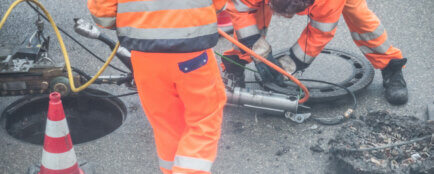What is the employee’s responsibility?
The institution of employee liability is based on the Labour Code and has specific rules. An employee is liable for damage caused by his or her culpable breach of duties in the performance of his or her work tasks. However, in the case of unintentional misconduct, the employee is obliged to compensate for the damage up to a maximum of 4.5 times his average monthly earnings. This limit is important to protect employees from liquidated claims.
The exceptions to this are if the damage was caused intentionally, under the influence of alcohol or drugs, or if it was a criminal offence – in which case you can claim full compensation from your employee.
It is crucial for you as an employer to always be able to properly document the damage and prove that it was actually caused by the fault of a particular employee. For example, when it comes to damage caused while working with machinery or a company vehicle, there is often a problem as to whether it was the worker’s fault or a technical fault. In order to avoid similar disputable situations, we recommend setting clear and understandable rules for the use of company property and at the same time keeping a thorough record of it. This will ensure that you have a solid evidentiary basis in the event of damage and significantly increase your chances of successfully claiming compensation.
Are you solving a similar problem?
Leave the documentation to us
If you want to make sure your agreements, guidelines and processes are legally sound, contact us. We can prepare a model material liability agreement, set up internal regulations and advise you on insurance.
More information
- When you order, you know what you will get and how much it will cost.
- We handle everything online or in person at one of our 6 offices.
- We handle 8 out of 10 requests within 2 working days.
- We have specialists for every field of law.
You can draw up liability agreements
If you want to have a stronger legal position, use the option of entering into written liability agreements with employees for shortfalls in entrusted values that the employee is required to account for. These are particularly used when the employee handles money, valuables or goods. By signing such an agreement, the employee undertakes to take full responsibility for the values entrusted to him, i.e. beyond 4,5 times his salary.
Remember that the agreement must always be in writing and clearly define what values the employee is taking over. Without a written form, the agreement is invalid. Employees under the age of 18 may not sign it. So, if you are entrusting employees with cash, stock or valuables, never underestimate the formality and always have them sign a material responsibility agreement.
It is essential for you to not only have a signed material responsibility agreement, but also to have a system in place to regularly hand over and check the funds entrusted to you. If you don’t have proper records, you could struggle to enforce your claim for compensation and risk failing in court.
Employees may be jointly liable for damages
A special category is joint material liability, where the agreement involves multiple employees who are jointly liable for the values entrusted to them. This is used, for example, in warehouses, stores or large cash registers where multiple people handle the values.
If you have an operation where more than one person handles values at the same time, use the institution of joint material responsibility. In practice, this means that employees agree to be jointly responsible for the values entrusted to them.
That way, if damage occurs and you cannot identify the specific culprit, you can divide the damage among all the employees who signed the agreement. The share of compensation will be determined for each employee according to the proportion of their gross earnings. If it is determined that all or part of the shortfall was caused by any of the jointly committed employees, then that employee must make up the shortfall in accordance with the degree of his or her fault.
Each employee (other than the manager and his deputy) may be liable to make good the loss up to a maximum of his average monthly earnings before the loss occurred. If this fails to cover the entire loss, the manager and his deputy must pay the remainder in proportion to their gross earnings.
This system also has a preventive effect, as employees are more vigilant about each other’s compliance and minimise the risk of fraud and theft. They are well aware that any loss will fall on them as well.
To avoid problems, make sure the agreement is precisely worded, employees are properly briefed and values are recorded and checked regularly.
If an employee refuses to sign the agreement, you cannot force them to do so. In this case, you will have to look for another way to secure the assets.
Tip for article
Tip: Serving as a member of a statutory body or in a senior management position carries not only prestige and responsibility, but also the risk of personal injury. All it takes is one wrong decision that damages the company – and the board of directors, managing director or CEO could face a lawsuit for damages. Read about executive liability.
What a model material liability agreement should look like
If you decide to use a material liability agreement, always work with a good quality template agreement. The agreement must clearly state:
- what values the employees are assuming,
- how they are recorded and controlled,
- what the employees’ obligations are in the event of loss or damage,
- when the agreement ends (e.g. when the job changes),
- signatures of both parties.
Don’t rely on generic internet templates – they are often outdated or worded too broadly so they won’t stand up in court. If you want to be sure, have a model material liability agreement tailored to your business. We’ll be happy to help.
How employers’ liability insurance can help you
You can take out voluntary insurance to cover, for example, any damage your employees might cause to third parties in the course of their work. But distinguish between insurance that the employee takes out (this protects them when they cause you harm) and insurance that you take out as an employer (this protects your business).
If you want real security, we recommend setting up a combination of both employee and employer insurance.
Put in place internal regulations and preventions
The basis of prevention is internal guidelines and rules. You should have a clear system of property records, conduct regular inventories and ensure that employees are trained in workplace safety and property handling.
Practical examples such as a four-eyes system for handling money, regular warehouse inventories or CCTV surveillance can also work well to significantly reduce the risk of fraud and errors. But it’s not just about legal cover, it’s also about setting a company culture – employees who know there are rules and controls are more prudent and responsible.
As an employer, if you underestimate prevention, subsequent recovery can be difficult. In fact, a typical example is disputes over whether the damage was caused by the employee’s negligence or whether poor working conditions contributed to it.
Tip for article
Tip: Whether you run an auto body shop, a coffee shop, an accounting business, or IT services from home, you have one thing in common with other businesses: you are liable for damages you cause to your clients, suppliers, or employees. Find out what business liability insurance covers.
Combination of prevention and insurance is best
The most reliable protection is a combination of prevention, written agreements and insurance. If you set clear rules, enter into material liability agreements and have appropriate insurance in place, you will minimise the risks to the lowest possible level.
We know from experience that companies that have implemented this combination have reduced claims by up to half. For example, one manufacturing company has introduced mandatory training for machine operators, material liability for warehouse workers and liability insurance at the same time. By combining all these measures, it managed to reduce damage by more than 50% in two years. This clearly shows that a well set-up system works not only legally but also economically.
Summary
As an employer, the best way to protect yourself from claims is through a combination of prevention, clear rules and appropriate insurance. A properly set-up system is essential – written material liability agreements with employees, or even joint material liability in warehouses or cash registers, will allow you to claim full compensation if a loss occurs. Remember that an employee is only liable for damages up to 4.5 times his or her salary, unless there is intent, alcohol or a criminal offence. That’s why it’s crucial for you to keep consistent records of assets, set up control mechanisms, conduct inventories and train employees regularly. However, you should also rely on insurance – both compulsory (for work-related accidents and occupational diseases) and voluntary, which covers damage caused to third parties. With a combination of agreements, prevention and insurance, you will minimise the risk of financial loss and protracted litigation, and if damage does occur, you will have all the necessary documents in hand to deal with it effectively.
Frequently Asked Questions
Can you instruct employees to take out liability insurance?
You can’t. They can take out insurance voluntarily, but you can recommend it to them.
What to do if an employee refuses to sign a material responsibility agreement?
You can’t force him. In that case, just don’t entrust him with values for which he should be fully responsible.
How should you charge an employee for compensation?
The reimbursement is accounted for as a receivable from the employee. If they agree, you can deduct it from their wages. If not, you have to go to court.
Can an employee also be held criminally liable?
Yes, if he or she caused the damage intentionally, by fraud or other criminal act, he or she may be criminally liable in the Czech Republic.




